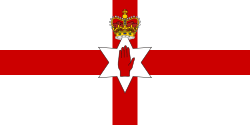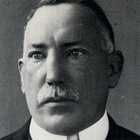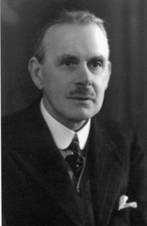Prime Minister of Northern Ireland
Northern Ireland 1921–72
|
|---|
 |
| This article is part of a series on the politics and government of Northern Ireland 1921–72 |
|
|
British politics portal |
The Prime Minister of Northern Ireland was the head of the Government of Northern Ireland between 1921 and 1972. No such office was provided for in the Government of Ireland Act 1920,[1] however the Lord Lieutenant,[2] as with Governors-General in other Westminster Systems such as in Canada, chose to appoint someone to head the executive even though no such post existed in statute law. The office-holder assumed the title Prime Minister to draw parallels with the Prime Minister of the United Kingdom. On the advice of the new Prime Minister, the Lord Lieutenant then created the Department of the Prime Minister.[3] The office of Prime Minister of Northern Ireland was abolished in 1972, along with the contemporary government, when direct rule of Northern Ireland was transferred to London.
The Government of Ireland Act provided for the appointment of the Executive Committee of the Privy Council by the Governor.[4] No parliamentary vote was required. Nor, theoretically, was the Executive Committee and its prime minister responsible to the House of Commons of Northern Ireland. In reality the Governor chose the leader of the party with a majority in the House to form a government. On each occasion this was the leader of the Ulster Unionist Party, such was the UUP's electoral dominance using both a simple plurality and for the first two elections, a proportional electoral system.
The Prime Minister's residence from 1920 until 1922 was Cabin Hill, later to become the junior school for Campbell College. After 1922 Stormont Castle was used, though some prime ministers chose to live in Stormont House, the unused residence of the Speaker of the House of Commons.
The new offices of First Minister and deputy First Minister were created by the Good Friday Agreement of 1998. In contrast with the Westminster-style system of the earlier Stormont government, the new Northern Ireland Executive operates on the principles of consociational democracy.
Prime Ministers
Ulster Unionist Party (UUP)
| # | Portrait | Name (Birth–Death) |
Term of Office | Party | Ministry | Election(s) | |
|---|---|---|---|---|---|---|---|
| 1 |  | Sir James Craig[5] (1871–1940) | June 7, 1921 | November 24, 1940 | Ulster Unionist Party | Craigavon | 1921 1925 1929 1933 1938 |
| 2 |  | John Miller Andrews (1871–1956) | November 27, 1940 | May 1, 1943 | Ulster Unionist Party | Andrews | – |
| 3 |  | Sir Basil Brooke[6] (1888–1973) | May 1, 1943 | March 26, 1963 | Ulster Unionist Party | Brookeborough | 1945 1949 1953 1958 1962 |
| 4 |  | Terence O'Neill (1914–1990) | March 25, 1963 | May 1, 1969 | Ulster Unionist Party | O'Neill | 1965 1969 |
| 5 |  | James Chichester-Clark (1923–2002) | May 1, 1969 | March 23, 1971 | Ulster Unionist Party | Chichester-Clark | – |
| 6 |  | Brian Faulkner (1921–1977) | March 23, 1971 | March 30, 1972 | Ulster Unionist Party | Faulkner | – |
Parliamentary Secretary, Department of the Prime Minister
- 1921-1929 The 12th Viscount Massereene
- 1929-1930 The 6th Viscount Bangor
- 1930-1941 John Andrew Long
- 1941-1948 Sir Joseph Davison
- 1948-1960 William Moore Wallis Clark
- 1960-1970 Daniel McGladdery
- 1970-1972 Captain John Brooke
Additional Parliamentary Secretary, Department of the Prime Minister
- 1969 Robert Simpson
Sources
- Alan J. Ward, The Irish Constitutional Tradition (Irish Academic Press, 1994)
- Government of Ireland Act, 1920
- The Government of Northern Ireland
| ||||||||||||||
Footnotes
- ↑ Alan J. Ward, The Irish Constitutional Tradition, p.111.
- ↑ The new office of Governor had not yet come into being because its creation required an amendment to the original Act. The Lord Lieutenant of Ireland had originally been granted the role and exercised the powers, functions and duties pending the creation of governor's post in 1922. Ward, p.116.
- ↑ Ward, p.116.
- ↑ Government of Ireland Act 1920, s. 8.
- ↑ Viscount Craigavon from 1927
- ↑ Viscount Brookeborough from 1952